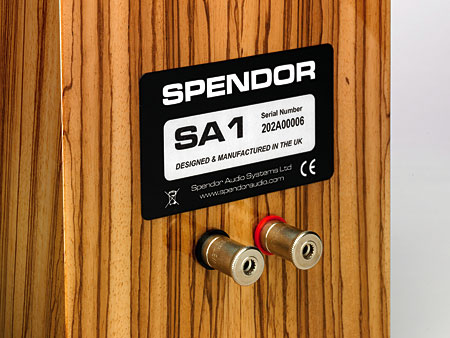| Columns Retired Columns & Blogs |
Spendor SA1 loudspeaker Page 2
Time for more piano. I played some 24-bit/88.2kHz test mixes of my current recording project, Robert Silverman performing Brahms' monumental Handel Variations and Schumann's Études Symphonique, scheduled for release on CD next spring. I had recorded these works in the superbly supportive acoustic of Sauder Concert Hall in Goshen, Indiana, and had gotten fairly close to the Steinway, in order to get the optimal balance between a sparkling piano sound and the surrounding ambience. My provisional mix between the two primary pairs of mikes used —ORTF cardioids and spaced omnis —had been done using the Revel Salon2s as monitors. However, even though the image of the piano was palpable in the extreme, the instrument sounded a little lacking in top-octave air through the Spendors, particularly following the immediate-sounding piano used in the Ashkenazy Rachmaninoff recording. Had I mixed the recording using the Spendors as monitors, I would have used a little more contribution from the spaced omnis. Even so, Hyperion Knight's Steinway in the solo arrangements of the Gershwin songs on Rhapsody (CD, Stereophile STPH010-2), which I remastered during the Spendors' review period, did have sufficient top-octave sparkle now through the SA1s.
And again, I kept returning to that soundstage: spacious yet stable, expansive yet without individual instrumental or vocal images within that stage becoming bloated. Every instrument in the small orchestra used in Joel Cea's arrangement of Rhapsody in Blue on Rhapsody could be heard hanging unambiguously in the space around and behind the centrally placed piano from which Hyperion was leading them. The same was true for the five instruments on Jerome Harris's Rendezvous (CD, Stereophile STPH013-2). I had panned the image of Steve Nelson's vibes from center to far left, with Bill Drummond's drum kit occupying the full stage width, Harris's bass guitar and Art Baron's trombone center, and Marty Erlich's alto sax half-right. The placements were laid bare by the Spendors, with no instruments "splashing" to the sides at some frequencies, or having bloated images.

Though the bass guitar was easily audible on this recording, the kick drum did sound a little suppressed. The 1/3-octave warbles tones on Editor's Choice (CD, Stereophile STPH016-2) sounded progressively weaker below 80Hz, though the speaker was obviously getting a little help from the room with the 32Hz warble. But what bass there was could be heard to "speak" very cleanly with the toneburst track on Editor's Choice, which starts at 32Hz and moves up in half-steps or semitones.
Imagining
When John Marks reviewed the latest minimonitor from Canadian company PSB in February 2009, he concluded that the Imagine B ($1000/pair) not only had "an appearance and a level of fit'n'finish that were leagues ahead of its price," but also that it was "an important loudspeaker . . . superb value for money . . . and plays music surprisingly well while seeming to offer very little long-term risk of listener fatigue." I therefore held on to the review samples to use as the baseline for this series of reviews of bookshelf speakers.
That the PSB is 4dB more sensitive than the Spendor was very obvious in side-by-side comparisons. After adjusting for the resultant loudness difference, the Imagine Bs threw a similarly large soundstage to the SA1s', but with less stage depth. More important, their tonal balance was brighter, with more top-octave air, which made the Spendors sound a touch closed-in. On the plus side, the test mixes of the Silverman Brahms recording sounded more spacious on the PSBs; on the negative side, cymbals sounded a bit more sizzly than they did with the Spendors. In the bass, the PSBs had noticeably greater extension, with fairly good midbass weight. While the ported PSB speaker didn't speak as clearly at low frequencies as had the sealed-box Spendor, the former is definitely a more appropriate minispeaker to choose if you play a lot of classic rock. It also played a little louder before developing strain or midrange congestion.
What I did find over extended listening to the PSB was that its midrange had a little more character than the Spendor's. Piano recordings sounded a bit more clangy, and male voices acquired a slightly hooty coloration. The Spendor's midrange sounded more pure in this respect.
I also performed some comparisons with my 1978-vintage Rogers LS3/5a. I still love these speakers for all they have become renowned for doing right, but next to the almost identically sized Spendor SA1s, they sounded bright and nasal. Drive-unit development hasn't stood still in the past 30 years.
Summing up
Despite its tiny size, the Spendor SA1 proved surprisingly capable of providing sufficient low-end output for musical satisfaction. Its natural competition will be the other descendants of the BBC heritage, Harbeth's HL-P3ES-2 ($1850 –$2150/pair, but about to be replaced) and the Stirling LS3/5A v2 ($1995/pair), both of which I reviewed in April 2007 but neither of which I had to hand for this review, unfortunately. The Harbeth offers a similar tonal balance with almost identical LF extension; the Stirling has a brighter, less forgiving balance than either, with a more exaggerated upper bass. But the Spendor also faces stiff opposition from the Chinese-made PSB Imagine B; at half the SA1's price, the PSB offers greater LF quantity, if not quite quality. The PSB's brighter tonal balance will make greater demands on both recordings and the rest of the system, however, and its slightly more colored midrange will be a factor if you play a lot of solo-piano or vocal recordings.
Overall, Spendor's SA1 offers superbly musical reproduction from a surprisingly small package. I strongly recommend it, particularly to those who have small rooms and high expectations.
- Log in or register to post comments




































